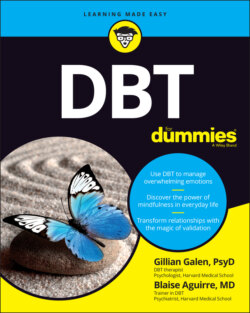Читать книгу DBT For Dummies - Gillian Galen - Страница 94
Looking at what causes you distress
ОглавлениеLooking at what commonly causes you distress can help you anticipate challenging situations. When you can anticipate difficult situations or interactions, it gives you time to plan ahead so that you aren’t continually experiencing distress in the same situations. Knowing your common areas of distress will also help you validate your experience, which, as we discuss earlier in this chapter, will help you keep painful emotions from building in intensity.
A wide range of things cause people distress, and each of us has unique areas that we find harder to manage, based on our sensitivity and experiences. When you begin to think about this, some situations may be quite obvious and easy to identify, while others may take more time to figure out. Consider the following questions:
Is there something you do that repeatedly causes you distress (posting on social media, being with certain people, going to certain places)?
Are there certain relationships or interactions that repeatedly cause you distress?
Are there certain holidays or gatherings that repeatedly cause you distress?
Are there certain places you go (work, school, restaurants, people’s houses) that repeatedly cause you distress?
Are there situations that repeatedly cause you distress (hearing the word no, receiving a compliment, receiving feedback at work or from a friend, saying no to someone)?
Are there certain emotions that are harder to manage and that frequently cause you distress?
Thinking about these experiences will help you narrow down specific areas that you can focus your skills on so that you don’t keep finding yourself in similar painful situations over and over again.
